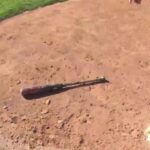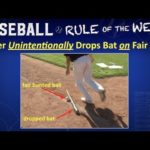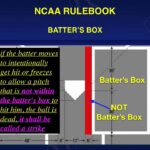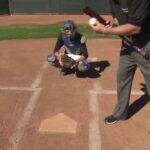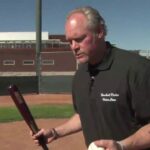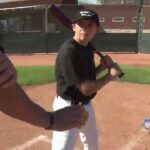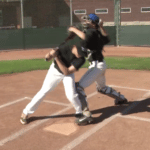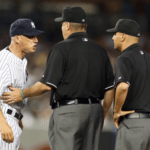6.03 Batter Illegal Action
(a) A batter is out for illegal action when:
(1) He hits a ball with one or both feet on the ground entirely outside the batter’s box.
Rule 6.03(a )(1) Comment:
If a batter hits a ball fair or foul while out of the batter’s box, he shall be called out. Umpires should pay particular attention to the position of the batter’s feet if he attempts to hit the ball while he is being intentionally passed. A batter cannot jump or step out of the batter’s box and hit the ball.
(2) He steps from one batter’s box to the other while the pitcher is in position ready to pitch;
(3) He interferes with the catcher’s fielding or throwing by stepping out of the batter’s box or making any other movement that hinders the catcher’s play at home base.
(4) He throws his bat into fair or foul territory and hits a catcher (including the catcher’s glove) and the catcher was attempting to catch a pitch with a runner(s) on base and/or the pitch was a third strike.
EXCEPTION to Rules 6.03(a)(3) and (4): Batter is not out if any runner attempting to advance is put out, or if runner trying to score is called out for batter’s interference.
Rules 6.03(a )(3) and (4) Comment:
If the batter interferes with the catcher, the plate umpire shall call “interference.” The batter is out and the ball dead. No player may advance on such interference (offensive interference) and all runners must return to the last base that was, in the judgment of the umpire, legally touched at the time of the interference. If, however, the catcher makes a play and the runner attempting to advance is put out, it is to be assumed there was no actual interference and that runner is out—not the batter. Any other runners on the base at the time may advance as the ruling is that there is no actual interference if a runner is retired. In that case play proceeds just as if no violation had been called.
If a batter strikes at a ball and misses and swings so hard he carries the bat all the way around and, in the umpire’s judgment, unintentionally hits the catcher or the ball in back of him on the backswing, it shall be called a strike only (not interference). The ball will be dead, however, and no runner shall advance on the play.
(5) He uses or attempts to use a bat that, in the umpire’s judgment, has been altered or tampered with in such a way to improve the distance factor or cause an unusual reaction on the baseball. This includes bats that are filled, flat-surfaced, nailed, hollowed, grooved or covered with a substance such as paraffin, wax, etc.
No advancement on the bases will be allowed (except advancements that are not caused by the use of an illegal bat, e,g., stolen base, balk, wild pitch, passed ball), and any out or outs made during a play shall stand. In addition to being called out, the player shall be ejected from the game and may be subject to additional penalties as determined by his League President.
Rule 6.03(a)(5) Comment:
A batter shall be deemed to have used or attempted to use an illegal bat if he brings such a bat into the batter’s box.
(b) Batting Out of Turn
(1) A batter shall be called out, on appeal, when he fails to bat in his proper turn, and another batter completes a time at bat in his place.
(2) The proper batter may take his place in the batter’s box at any time before the improper batter becomes a runner or is put out, and any balls and strikes shall be counted in the proper batter’s time at bat.
(3) When an improper batter becomes a runner or is put out, and the defensive team appeals to the umpire before the first pitch to the next batter of either team, or before any play or attempted play, the umpire shall (1) declare the proper batter out; and (2) nullify any advance or score made because of a ball batted by the improper batter or because of the improper batter’s advance to first base on a hit, an error, a base on balls, a hit batter or otherwise.
(4) If a runner advances, while the improper batter is at bat, on a stolen base, balk, wild pitch or passed ball, such advance is legal.
(5) When an improper batter becomes a runner or is put out, and a pitch is made to the next batter of either team before an appeal is made, the improper batter thereby becomes the proper batter, and the results of his time at bat become legal.
(6) When the proper batter is called out because he has failed to bat in turn, the next batter shall be the batter whose name follows that of the proper batter thus called out.
(7) When an improper batter becomes a proper batter because no appeal is made before the next pitch, the next batter shall be the batter whose name follows that of such legalized improper batter. The instant an improper batter’s actions are legalized, the batting order picks up with the name following that of the legalized improper batter.
Rule 6.03 (b)(7) Comment: The umpire shall not direct the attention of any person to the presence in the batter’s box of an improper batter. This rule is designed to require constant vigilance by the players and managers of both teams. There are two fundamentals to keep in mind: When a player bats out of turn, the proper batter is the player called out. If an improper batter bats and reaches base or is out and no appeal is made before a pitch to the next batter, or before any play or attempted play, that improper batter is considered to have batted in proper turn and establishes the order that is to follow.
APPROVED RULING: To illustrate various situations arising from batting out of turn, assume a first-inning batting order as follows:
Abel-Baker-Charles-Daniel-Edward-Frank-George-Hooker-Irwin.
PLAY (1) — Baker bats. With the count 2 balls and 1 strike, (a) the offensive team discovers the error or (b) the defensive team appeals. Ruling—In either case, Abel replaces Baker, with the count on him 2 balls and 1 strike.
PLAY (2)—Baker bats and doubles. The defensive team appeals (a) immediately or (b) after a pitch to Charles.
RULING: (a) Abel is called out and Baker is the proper batter; (b) Baker stays on second and Charles is the proper batter.
PLAY (3)—Abel walks. Baker walks. Charles forces Baker. Edward bats in Daniel’s turn. While Edward is at bat, Abel scores and Charles goes to second on a wild pitch. Edward grounds out, sending Charles to third. The defensive team appeals (a) immediately or (b) after a pitch to Daniel.
RULING: (a) Abel’s run counts and Charles is entitled to second base since these advances were not made because of the improper batter batting a ball or advancing to first base. Charles must return to second base because his advance to third resulted from the improper batter batting a ball. Daniel is called out, and Edward is the proper batter; (b) Abel’s run counts and Charles stays on third. The proper batter is Frank.
PLAY (4)—With the bases full and two out. Hooker bats in Frank’s turn, and triples, scoring three runs. The defensive team appeals (a) immediately, or (b) after a pitch to George.
RULING: (a) Frank is called out and no runs score. George is the proper batter to lead off the second inning; (b) Hooker stays on third and three runs score. Irwin is the proper batter.
PLAY (5)—After Play (4)(b) above, George continues at bat. (a) Hooker is picked off third base for the third out, or (b) George flies out, and no appeal is made. Who is the proper leadoff batter in the second inning?
RULING: (a) Irwin. He became the proper batter as soon as the first pitch to George legalized Hooker’s triple; (b) Hooker. When no appeal was made, the first pitch to the leadoff batter of the opposing team legalized George’s time at bat.
PLAY (6 )—Daniel walks and Abel comes to bat. Daniel was an improper batter, and if an appeal is made before the first pitch to Abel, Abel is out, Daniel is removed from base, and Baker is the proper batter. There is no appeal, and a pitch is made to Abel. Daniel’s walk is now legalized, and Edward thereby becomes the proper batter. Edward can replace Abel at any time before Abel is put out or becomes a runner. He does not do so. Abel flies out, and Baker comes to bat. Abel was an improper batter, and if an appeal is made before the first pitch to Baker, Edward is out, and the proper batter is Frank. There is no appeal, and a pitch is made to Baker. Abel’s out is now legalized, and the proper batter is Baker. Baker walks. Charles is the proper batter. Charles flies out. Now Daniel is the proper batter, but he is on second base. Who is the proper batter?
RULING: The proper batter is Edward. When the proper batter is on base, he is passed over, and the following batter becomes the proper batter.



